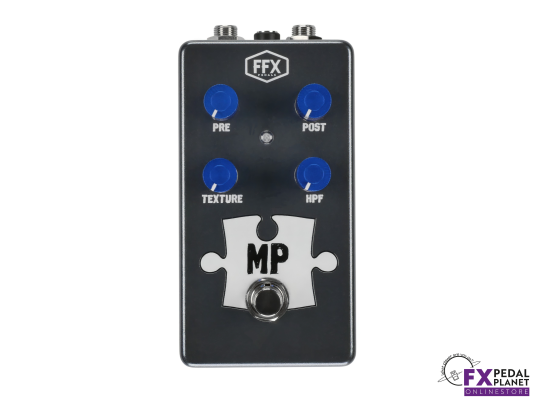
Breaking the Rules: Intensive Care Audio’s Death Muff
When it comes to fuzz, few builders embrace chaos quite like Dr P of Intensive Care Audio. Known for wild, unapologetically experimental circuits, the London based pedal maker has earned a reputation for creating sounds that are as unruly as they are inspiring. Their latest concoction, The Death Muff, takes the familiar DNA of a Big Muff and subjects it to a series of sonic mutations, spliced with the brand’s own Death Drive and pushed to delirious new extremes.
In this interview, we speak with the mind behind Intensive Care Audio about the philosophy, experimentation, and happy accidents that shaped The Death Muff. From circuit bending quirks to the fine line between chaos and control, it’s a deep dive into what happens when distortion becomes art.
What were your main goals when designing The Death Muff — were you aiming for pure chaos, or something more refined beneath the madness?
I wanted to try and smash together parts of a Big Muff with parts of the Death Drive, so I started with the three Muff gain stages and built the Death Drive input and output stages around them, also using the tone stack from the Death Drive. The end result is Muff gain stages that are being hit way harder at the input and then slamming into another gain stage or two. I then spent quite a long time tuning it to get some nastier, gated, velcro like sounds out of the circuit, which the Muff isn’t really known for. I wanted to use the Muff as a starting point but get away from traditional Muff sounds; there are a billion pedals that sound like Muffs, so I didn’t want to make another one.
The Death Muff has a reputation for wild textures. How do you personally describe its “voice” compared to other fuzz pedals?
I’d say it’s a gnarly, gated, spitting, unruly fuzz, but it does have a softer side, especially when you use your guitar’s volume. It cleans up in an interesting way and unlocks a whole range of tones.
The CHAOS control adds a unique layer of unpredictability. Was that inspired by a particular sound, circuit, or creative accident?
I think when I had it on the breadboard I was just trying to squeeze as much gain out of it as possible, and found there were two ways of adjusting the gain, both of which reacted completely differently and also interacted in an interesting way, so I thought, why not keep both?
Many players fear losing clarity with fuzz pedals. How did you approach maintaining note definition while keeping the aggression intact?
There’s a fair bit of filtering going on to keep all the flub out of the gain stages, which means all the gain is focused in the midrange and above, that keeps things tight.
You describe The Death Muff as a “medicine” for dull tones — if you had to write a prescription, what dosage would you recommend?
I’d say: take one pedal, 1 to 2 hours a day.
The control layout seems deliberately simple but deceptively interactive. How important was it to keep the interface accessible while offering depth?
I wanted to keep the control layout the same as the Death Drive to further drive home the point that it’s a mash up of the two pedals, so that was probably the deciding factor. I guess having two gain controls is a little unusual, but as with the Death Drive, I like the way the two controls interact and give you the ability to find sounds you just couldn’t with one control.
Fuzz circuits are famously temperamental. Were there any “happy accidents” or unexpected results during the development process?
When messing around with fuzz circuits on the breadboard, I always flip transistors and plug them in backwards. Sometimes it works, sometimes it doesn’t. Sometimes it’s fun and interesting to try and use components in a way that isn’t correct, if there’s such a thing.
Intensive Care Audio pedals always sound distinct from typical clones. How do you approach circuit design to ensure each release has its own personality?
I don’t have much interest in clones, to be honest. I may use existing circuit snippets as jumping off points, but from there I like to experiment and use my ears to reach either a sound I already have in my head, or find something new that excites me. Or sometimes I just come up with a stupid pun and then work backwards to decide what pedal it should be.
Finally, if The Death Muff could “collaborate” with another Intensive Care Audio pedal for a killer pairing, which one would you prescribe?
The other day I had a lot of fun running it after the Valco FX KGB Fuzz, which has a really cool input impedance control that made the two pedals interact in interesting ways.
A huge thank you to Dr P from Intensive Care Audio for taking the time to talk with us and for his continued support of FX Pedal Planet Online Store. His fearless approach to circuit design and sound experimentation perfectly captures what makes boutique pedals so exciting, innovation driven by passion rather than convention.
We’re thrilled to announce that The Death Muff will soon be available at FX Pedal Planet Online Store, so be sure to keep an eye on our website and social media pages for its arrival.
In the meantime, we highly recommend checking out more of Intensive Care Audio’s incredible work by visiting their official website, and showing your support by following both Intensive Care Audio and FX Pedal Planet Online Store on social media. Every like, follow, and share helps keep independent builders and retailers thriving and brings more great gear to your pedalboards.































































